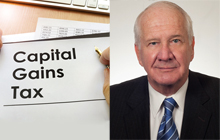The new game in town: Capital gains and the alternative minimum tax

The federal government's new capital gains rules have left taxpayers in a pickle says Allan Lanthier. But here's a planning alternative with a deadline of June 24
 |
Allan Lanthier is a retired partner of an international accounting firm, and has been an adviser to both the Department of Finance and the Canada Revenue Agency. |
Editor's Note: We also recommend reading the author's follow-up article, Crystallizing capital gains before June 25: What about the GAAR?
MONTREAL – As readers will know, the federal government’s budget of April 16, 2024 proposed an increase in the capital gains inclusion rate from 50 percent to two-thirds, effective for capital gains realized on or after June 25, 2024, and also announced new rules for calculating the alternative minimum tax (AMT) for taxation years that begin after December 31, 2023.[1]
This article does not comment on the merits of the capital gains increase or the AMT changes, or provide a detailed analysis of either proposal. Its purpose is more limited: to point out that there is a new game in town – a planning alternative with a deadline of June 24: individuals who are considering capital gains realization transactions before June 25 should also consider transferring capital properties to a corporation on a rollover basis as a first step,[2] followed by a corporate realization of the capital gains.
The AMT
An AMT on individuals was announced in Conservative Finance Minister Michael Wilson’s 1985 federal budget. The budget stated that the AMT would “enhance the fairness of the tax system” by imposing an additional tax on high-income individuals who use tax incentives “to pay little or no tax”. After consultations and debate, the AMT took effect on January 1, 1986.[3]
The AMT is a parallel tax calculation that allows fewer deductions, exemptions and credits than the regular personal tax calculation. After computing “adjusted taxable income” (ATI) and deducting a basic exemption of $40,000,[4] minimum tax applies at a rate of 15 percent, and tax credits are then applied. If the AMT exceeds regular personal tax, the excess increases tax payable for the year.[5]
For example, ATI has an inclusion rate of 30 percent for capital gains eligible for the lifetime capital gains exemption (LCGE) and 80 percent for other capital gains; losses from flow-through shares, certified Canadian films and rental and leasing properties are denied; and dividends received from taxable Canadian corporations are taxed without reference to either the gross-up or dividend tax credit.
In addition to the federal AMT, the provinces and territories have adopted AMTs, generally as a percentage of the difference between federal AMT and regular federal tax: the province of Quebec has its own set of rules. There is generally no corporate-level minimum tax in Canada.[6]
The proposed changes to the AMT:
The government has proposed a number of changes to the AMT, which generally take effect on January 1, 2024: the changes are significant.
Under the new rules, 100 percent of capital gains will be included in ATI (other than gains eligible for the LCGE),[7] the basic exemption will increase from $40,000 to about $173,000,[8] and the AMT rate will increase to 20.5 percent. The actual amount of taxable dividends from taxable Canadian corporations will continue to be taxed without gross-up or credit.
New restrictions also apply for a number of deductions and credits, restrictions that seem impossible to justify except for the fact that the government needs all the revenue it can get at this time.[9]
The capital gains inclusion rate
Effective June 25, 2024, the inclusion rate for capital gains will increase from 50 percent to two-thirds for corporations, trusts and individuals: for individuals, the inclusion rate will remain at 50 percent for the first $250,000 of annual capital gains. Draft legislation has not been released, and so taxpayers and their advisers can only guess at what the final rules will say.
As noted, the increased inclusion rate did not take effect for capital gains realized on or after the budget date. Instead — and for reasons the government did not explain — there was a 10-week delay in the effective date until June 25. In my view, the delay is in place to force taxpayers to realize capital gains before June 25, with the tax revenues from those realizations allowing the government to project that it will respect its “fiscal anchors” in 2024-2025 and keep its projected deficit for that fiscal year just slightly below $40 billion.
To realize or not to realize, that is the question
There are less than seven weeks remaining before the deadline date of June 25, so what to do? One approach would be to look at the amount of regular tax at the 50 percent and two-thirds inclusion rates, consider the time value of money and when the capital gain might otherwise be realized, and make a decision based on those factors.
For example, the combined federal-provincial tax at the top bracket for an individual who is a resident of British Columbia is 53.50 percent. The tax on a capital gain is therefore 26.75 percent based on a 50 percent inclusion rate. For capital gains realized or after June 25, the tax will be 35.67 percent (two-thirds times 53.50 percent) after the first $250,000 of gains. However, these tax rates don’t give the full picture because they exclude the impact of the AMT.
There is no easy way to determine an individual’s personal tax rate after factoring in the AMT, because each situation is different. The amount of AMT will depend on the individual’s sources of income for the year — full rate employment income for example, versus capital gains with an inclusion rate or dividends with and without a gross-up and credit.
However, if an individual realizes very significant capital gains in a year — say $100 million to make the point — the impact of factors such as the LCGE and the AMT exemption of $173,000 can safely be ignored as almost “rounding errors”. In this situation, a top-bracket individual resident in British Columbia will have a tax rate of 32.10 percent for capital gains realized before June 25: the regular rate of 26.75 percent plus federal and provincial AMT of 5.35 percent.[10]
Now let’s see what happens if an individual in this situation is able to realize the capital gain today, but at the corporate level instead.
Hypothetical example
Crystal, an individual resident in Vancouver, owns 100 percent of Co. A, a Canadian corporation that manufactures custom drills and machine parts. Crystal started the company from scratch many years ago and, thanks to hard work and dedication, the company has prospered.
Crystal is thinking about retirement, and has received expressions of interest from third parties to purchase the company. The shares of Co. A have a fair value of about $10 million, and Crystal’s tax cost is nominal.
Her tax accountant says that, if she crystallizes the $10 million gain before June 25, her tax cost will be about $3.210 million including AMT, while a sale on or after that date will cost about $3.567 million.[11] But he suggests another alternative.
Crystal would form another Canadian corporation (Holdco), and transfer her shares of Co. A to Holdco on a share-for-share basis, electing a nominal amount under subsection 85(1) of the Act. Holdco then incorporates Holdco 2, and Holdco transfers the shares to Holdco 2, electing an amount of $10 million under subsection 85(1). Crystal now has time to negotiate with potential purchasers over the next few months. Her accountant explains that, after a third-party sale of the shares of Co. A, the after-tax cash in Holdco 2 would be creditor protected. And even better, the immediate tax to Holdco would be substantially less than $3.210 million.
The federal-provincial corporate tax rate in British Columbia on investment income — which includes the taxable portion of capital gains — is 50.67 percent. Should Holdco realize the $10 million capital gain before June 25 at a 50 percent inclusion rate, its immediate tax will be $2.534 million, a savings of more than 21 percent compared to the tax cost of $3.210 million that Crystal would have paid had she crystallized the gain personally.
Of course, the story doesn’t end there. While Holdco will now have a capital dividend account of $5 million that can be paid as tax-free dividends to Crystal, the remaining after-tax funds would be paid to Crystal over the next several years as non-eligible dividends, at an effective rate of 48.89 percent at the top bracket in British Columbia. After all such dividends have been paid, and “refundable dividend tax on hand” has been recovered by Holdco, the combined corporate-personal tax to Holdco and Crystal should be $2.956 million,[12] which is still a long-term savings of close to 8 percent compared to Crystal’s personal tax cost of $3.210 million.
In summary, individuals such as Crystal may be able to creditor-proof after-tax cash in a Holdco, and reduce their effective tax rate by about 21 percent on a short-term basis and 8 percent long-term. But the planning opportunity will come to a screeching halt on June 25.[13]
So what’s the catch?
There really aren’t any catches, but there are at least three issues to keep in mind. First, the government may have a last-minute change of heart regarding the increase in the capital gains inclusion rate. Second, the characterization of the gain realized by Holdco as being on income or capital account should be considered. And third, consideration should be given to the possible application of the general anti-avoidance rule.
Will there be a last-minute change of heart?
Criticisms regarding the capital gains hike continue to pile up. While the government is sticking to its guns thus far, the last-minute fiascos with both the underused housing tax and bare trust reporting mean that nothing should be taken for granted: an early capital gains realization in anticipation of a proposed tax hike that disappears would be unfortunate, to say the least.
However, in the Crystal example, the filing of the subsection 85(1) election for the transfer from Holdco to Holdco 2 — and determining the election amount for that transfer — can be deferred as a partial hedge against yet another possible government retreat.
Is the gain to Holdco on income or capital account?
Having regard to the short period of time that Holdco will own the shares of Co. A before it transfers the shares to Holdco 2, a question arises regarding whether Holdco’s gain arises from an adventure or concern in the nature of trade. However, the 2016 decision of the Federal Court of Appeal in Gervais,[14] and the FCA’s validation in that decision of the principles established by the Supreme Court of Canada in 1962 in Irrigation Industries,[15] should put this question to rest, particularly for shares of a corporation.[16]
In Gervais, the FCA confirmed that shares are to be characterized as capital property unless the transferee has a reasonable expectation of profit: in the Crystal example, Holdco has none.[17]
The brave new world of GAAR:
What article on tax planning would be complete without reference to the brave new world of GAAR, with its preamble, revised threshold for an “avoidance transaction”, an economic substance test and a 25 percent penalty?
In a recent interpretation letter,[18] the Canada Revenue Agency commented on the possible application of the GAAR – and in particular on the economic substance condition — to pre-June 25 crystallization transactions, including in non-arm’s transactions. In the letter, the CRA states that it is cognizant of the fact that the delay in the implementation of the increased inclusion rate was a deliberate policy choice, and that the GAAR should generally not apply to redetermine the inclusion rate in respect of a crystallized capital gain.
That said, a possible additional question is whether a pre-June 25 crystallization following the transfer of a capital asset by an individual to a corporation represents a misuse or abuse. I suggest that the clear answer is “no”.
Tax integration has been a basic principle of the Canadian tax regime since 1972 tax reform. Tax integration means that both taxpayers and the CRA should generally be indifferent whether investment income, including the taxable portion of capital gains, is earned personally or by a private corporation: indifferent in the sense that the income will be taxed at approximately the same rate in either case.
Tax integration does not mean perfection of course. Even with increasingly complex legislation with acronyms such as ERDTOH, NERDTOH, GRIP and LRIP, effective tax rates are never the same. For example, the dividend gross-up and credit factors almost always result in under-integration, and a higher effective tax rate, if investment income is earned by a private corporation rather than personally.
On the flip side, there will be lower short and long-term effective rates as a result of the budget proposals if capital gains are realized by private corporations between January 1 and June 24, 2024. In my view, a decision to realize capital gains at the corporate-level is consistent with the object and spirit of the Act and conforms with one of the key principles of the Canadian tax regime. Nonetheless, with concepts as new and untested as those now found in the GAAR, downside risks should always be considered.
Conclusion
The government has left taxpayers in a pickle. It decided to delay the implementation date of the capital gains increase, and has told taxpayers to plan as best they can no later than June 24, without a single word of draft legislation. This article sets out one planning alternative that should be considered in appropriate circumstances.
Footnotes
[1] Legislative proposals to implement the AMT changes were included in a Notice of Ways and Means Motion released on April 30, 2024. On May 2, 2024, Bill C-69 received first reading in the House of Commons.
[2] In accordance with subsection 85(1) of the federal Income Tax Act; RSC 1985, c. 1 (5th Supp.), as amended (referred to in this article as the “Act”).
[3] Section 127.5 et. seq. of the Act.
[4 The exemption of $40,000 has been in place without indexation since 1986.
[5] The excess is available for a seven year carry forward, and deducted from tax if regular tax exceeds AMT in any of those years.
[6] However, the province of Ontario has a 2.7 percent corporate minimum tax based on adjusted financial statement income if total assets and revenue exceed prescribed limits.
[7] The inclusion rate for gains that qualify for the LCGE will remain at 30 percent.
[8] The basic exemption will be the indexed amount for the fourth highest federal income tax bracket, which is approximately $173,000 in 2024.
[9] For example, there will be a 50 percent disallowance of moving expenses, child care expenses, disability support payments and most employment expenses. In addition, most credits will be limited to 50 percent of the amounts otherwise available to reduce regular tax: an 80 percent limitation will apply for the charitable donation credit.
[10] Author’s calculations. The federal AMT is four percentage points above the regular rate — 20.5 percent less [33 percent times one-half]. Provincial AMT adds 1.35 percent — a factor of 33.7 percent in British Columbia, times 4 percent.
[11] Using the federal-provincial rate of 53.50 percent and a two-thirds inclusion rate. In principle, AMT should not apply because the top federal rate of 33 percent times two-thirds is 22 percent, higher than the federal AMT of 20.5 percent.
[12] Author’s calculations. In principle, AMT should not apply on Crystal’s receipt of non-eligible dividends. A non-eligible dividend of $10,000 is grossed-up by 15 percent, the grossed-up amount of $11,500 is taxed at a top federal rate of 33 percent (tax of $3,795) and a federal tax credit of $1,038 (9/13 of the gross-up) then applies to reduce the regular federal tax to an amount of $2,757. The federal AMT on a $10,000 dividend should only be $2,050.
[13] For dispositions on or after June 25, 2024, the personal tax for a top-rate taxpayer in British Columbia on a capital gain with a two-thirds inclusion rate (without reference to the first $250,000 of gains or AMT) will be 35.67 percent, versus an immediate corporate rate for a CCPC or Substantive CCPC of 33.78 percent. While there should therefore be a short-term savings for capital gains realized at the corporate level, as a result of under-integration the long-term rate is 39.41 percent once non-eligible dividends are paid to the shareholder (author’s calculations).
[14] Gervais et al v. The Queen et al: 2016 FCA 1.
[15] Irrigation Industries Ltd. v. MNR: 62 DTC 1131.
[16] Also see the 1998 SCC decision in The Queen v. Continental Bank of Canada: 98 DTC 6501. Characterization of a gain as being on income account was not raised in the 2024 Tax Court of Canada decision in DAC Investment Holdings Inc. v. The King, notwithstanding a short holding period: 2024 TCC 63.
[17] To ensure there is no economic profit in Holdco, a price adjustment clause should be included as part of the transfer agreements between Crystal and Holdco, and between Holdco and Holdco 2. In addition, the shares issued by Holdco to acquire the shares of Co. A should have a legal stated capital equal to the fair value of the Co. A shares, and this value should be reflected in the transfer agreement, the directors’ minutes, and the financial accounts of Holdco (see the 2002 FCA decision in Teleglobe Canada Inc. v. The Queen: 2002 FCA 408).
[18] Document number 2024-1016011E5(E) dated April 29, 2024.
Allan Lanthier, a retired partner of an international accounting firm, has been an adviser to both the Department of Finance and the Canada Revenue Agency.







(0) Comments